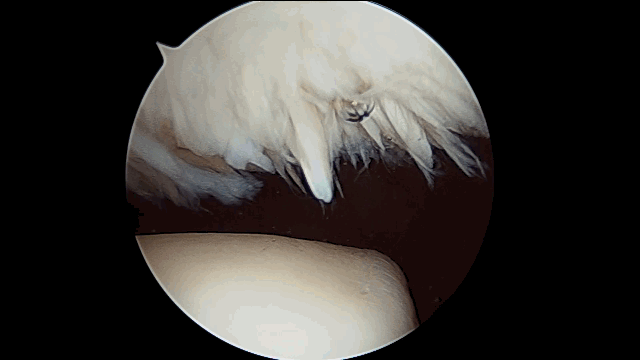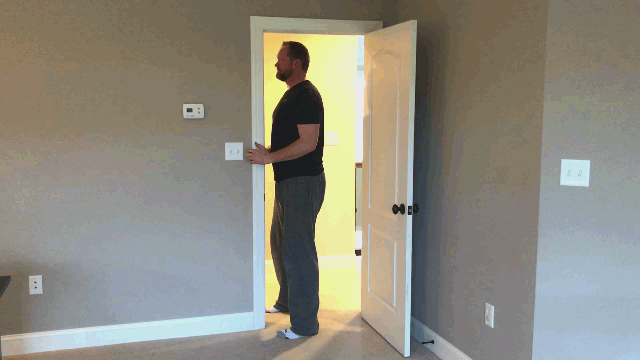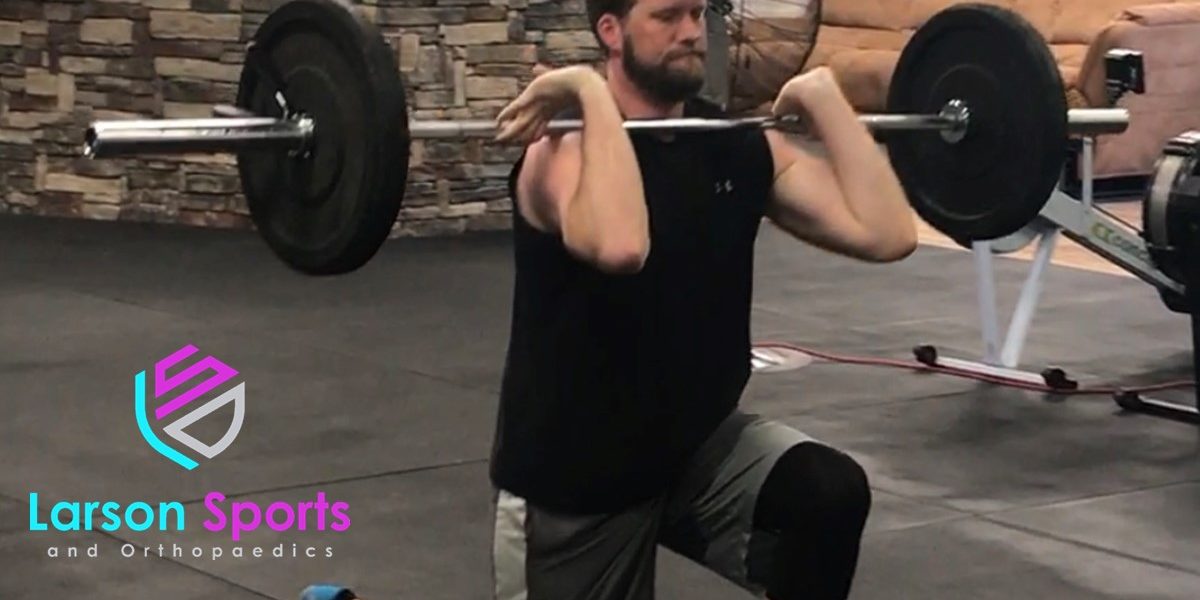Let me tell you about my knees. “Righty” likes to play sports, take long walks on the beach, and has no trouble with stairs. “Lefty” likes to complain. He makes noise when I squat, he doesn’t pull his weight in the gym, and he used to hurt all the time. Sound familiar? You probably have chondromalacia patella, like me. Do you want to learn how I managed to stop the pain?
I’m an orthopedic surgeon and I started this blog to help people stay active and healthy throughout their whole life. Which is why I am writing this article. To let you know that you CAN still exercise and stay fit, even with chondromalacia patella. I’ll tell you all about how I manage to play volleyball and lift heavy, even in my forties, with some pretty nasty cartilage damage.
What is chondromalacia patella?
First of all, let’s define the problem. Chondromalacia is what comes before arthritis. It’s pronounced kon-dro-mah-lay-sha. Chondromalacia is damage to the cartilage that lines the ends of your bones. Cartilage normally helps the joint to glide smoothly. In fact, it’s so smooth that a normal joint has less friction than rubbing ice on ice! 1,2
Chondromalacia patella is a condition where the cartilage on the undersurface of the kneecap sustains damage. That eventually results in the cartilage softening, cracking, and peeling apart. The cartilage can eventually peel off in pieces, leaving bare bone exposed. That’s when we start to call it arthritis instead of just chondromalacia. But there isn’t a rule on where we draw that line; there’s a bit of a grey zone between chondromalacia and arthritis.

What causes chondromalacia patella?
Your kneecap normally sits over the front of your knee joint. When you bend your knee or squat, the backside of your kneecap glides over the cartilage of your femur. But there is a complex network of tendons and ligaments that keeps your kneecap centered over a groove in the femur. And if there is poor alignment of this joint, it can lead to uneven pressure on the cartilage. This abnormal rubbing can lead to damage to the cartilage, resulting in chondromalacia patellae.
Improper kneecap alignment may result from a wide variety of factors. Some of the most common include:
- Unequal Leg Lengths
- Lumbar or Pelvic Angulation
- Scoliosis
- Tight Hamstrings
- Weak Quadriceps
- Tight Hip Adductors
- Weak Hip Abductors
- Flat Feet
- High-Riding Patella (Patella Alta)
- Patellar Instability
- Abnormal Patellar Tendon Attachments
Who is at risk for chondromalacia patella?
In my case, my height was probably the biggest risk factor. Being 6’8” tall means that there is a lot of weight on my knees. And that weight gets magnified by the extreme leverage of my long femurs. Obesity can also put you at risk for painful patellar chondromalacia. And women are more likely to be affected because their knees are typically more angulated than men’s. Direct trauma to the knee, such as a fall or a car accident can also cause cartilage damage. But athletes that have spent a lot of their lives running and jumping can also develop chondromalacia patella from the chronic wear and tear.
What are the symptoms of chondromalacia patella?
Chondromalacia patellae will typically present as pain Deep in the front of the knee. Your knees may feel like mine used to: Not painful most of the time, but just very uncooperative when I tried to squat. That left knee just never seemed to want to bend all the way. It also stayed stiff and tight. Sometimes it would be visibly swollen. You can probably hear and feel crunching, grinding, and crackling in your knee when climbing the stairs or squatting. Of course, there are many other causes of knee pain. You can check out these other causes in our article Why Your Knee Hurts.
Diagnosing and grading chondromalacia patella
The main symptoms of chondromalacia (swelling, grinding, and pain) are unfortunately common to many disorders of the knee. So the only way to truly be sure of a diagnosis of chondromalacia is by getting an MRI, which allows us to see the cartilage inside the knee. As an orthopedic surgeon, my biggest concern is not just whether you have chondromalacia, but what has caused it. When I do an exam as a doctor, I will be looking for flat feet, abnormal knee alignment, or other causes of chondromalacia that can be corrected.
Orthopedic surgeons grade chondromalacia on a scale of 1 to 4.
- Grade 1 chondromalacia is merely softening of the cartilage.
- Grade 2 is when the cartilage surface begins to break up, and the cartilage becomes rough.
- Grade 3 is when long fissures develop in the cartilage, often with loose flaps of cartilage. Grade 3 may also show partial thickness loss of the cartilage.
- Grade 4 chondromalacia is when the cartilage peels off or wears down to the bone underneath.
Self Care of Chondromalacia
There are a number of things that you can do on your own to relieve the symptoms of chondromalacia in your knee.
Stretching
Stretching has been a big help, personally. Stretching of the quads is important since they attach directly to the patella. But stretching the hamstrings is also very important. Many people don’t realize that the hamstrings wrap all the way around from the back of your thigh to attach to the front of the shin and knee. Some hamstring fibers even attaching to the kneecap itself, so stretching the hamstrings can actually relieve a lot of pressure on the patella.
I recommend simple hamstring stretches on a daily basis. Stretching the quads and knee overall can be done with assisted squats. These can be done in doorway at home or with a pole at the gym to help slowly work on overall knee flexibility. See the next section for details on these assisted squats.
Strengthening
It can be hard to exercise when your knees hurt. But if you stick with it, the pain will get better and your function will improve. Strong muscles help support painful joints, so they cause less pain. That’s why proper exercise is one of the best ways to help your knees feel better.
What is the proper kind of exercise? Strength training is the best way to improve the function of the quads, which help to stabilize the patella. Bodyweight exercises like squats are more effective than weight machines like the leg extension. 3
Semi Squats
Doing semi-squats is a great place to start. Squat down as far as you can within pain tolerance, and then stand back up. It will hurt a bit, just keep it tolerable. You can’t make progress without some discomfort!
I recommend that you start with semi squats in a doorway. Stand sideways facing the door jamb one foot on either side. Then squat down using your hands for support, and stand back up. This helps you to squat with proper form and help yourself up with your arms if needed. You can also use the pole of a squat rack in the gym to help support yourself instead. This is how I started back into exercise after surgery for my chondromalacia! Start with 20 semi squats twice a day, and add 5 more to each session each week.

Braces
Braces have been shown to reduce pain from chondromalacia patella. And wearing them while exercising can help decrease your pain during the workout. Wearing braces during exercise can also help you get stronger, faster. By reducing pain and supporting your knee, the braces let you work out harder and longer, improving your strength gains.
I used a simple neoprene knee sleeve when I started rehabbing the knees. Check them out at this link: Knee Sleeves. They aren’t expensive, but they provide stability while keeping the knees warm and limber.
For many people, simple knee sleeves aren’t enough. The best braces are the kind designed to keep the kneecap in better alignment. That reduces pain and improves function. Check this link for my personal recommendation on a chondromalacia patella brace. The same kind of brace can be worn for everyday activities as well to reduce pain and improve activity tolerance. 4
Pain Relief
Anti-inflammatory medication, such as ibuprofen, help to reduce inflammation around the joint. Ice packs on the knees after activity can help quite a bit. And lidocaine patches are sold over the counter now. While they may not relieve the pain in the long term, they can help you get some sleep on nights when the pain is bad.
Medical Treatment for Chondromalacia
Physical Therapy
Physical therapy can help quite a bit even if your home exercise program hasn’t helped. These people have spent four years earning their degrees, after all. They can teach you a lot about proper body mechanics and how to simply move better. They can also help loosen the tissue about your joints, stretch better than you can on your own, and provide many pain-relieving treatments.
Surgery
Arthroscopic surgery may help if you can’t get relief any other way. This surgery involves making a couple of tiny poke-hole incisions in the front of the knee. We insert a camera in one, and instruments in the other. We usually perform a chondroplasty, where we use a tiny shaver to smooth any damaged cartilage on the back of the knee cap. This is actually the surgery that I had. And it allowed me to get back into the gym and rehab my knee. The video below isn’t from my knee, but rather from one of the arthroscopic surgeries I’ve performed on a patient with chondromalacia patella.
Another common procedure is a lateral release. This operation involves cutting some of your ligaments to release tension and allow for more movement. But if your chondromalacia patella is caused by previous dislocations of your kneecap, then doing a lateral release is a TERRIBLE idea! That could destabilize your knee even further, and increase the frequency of patella dislocations.
If your chondromalacia has gone to stage 4, where it has worn all the cartilage off and bare bone is exposed, then an arthroscopic surgery won’t be very successful. You would need a more invasive surgery such as cartilage restoration or realignment of the patella attachments to relieve pressure.
Tips to prevent chondromalacia patella
Your quadriceps and hamstrings play an active role in stabilizing your patella. The hip abductors and adductors keep your entire leg aligned properly. The gluteal muscles provide power without stressing the knees. Keep them all strong and limber to reduce the stress on your knees.
Learn how to squat properly so that you do it correctly every day. This helps to transfer the forces to your hips, which are capable of withstanding higher loads. The semi-squats in a doorway, as shown above, can really help out.
If you have flat feet and “knock knees” AKA valgus knees, try arch supports. This will correct your leg alignment from the ground up and reduce the stress on your knees.
Learn to do your daily activities better. Standing from a chair or climbing stairs can result in the accumulation of microscopic damage to your knee cartilage over time. Good posture with proper gluteal muscle activation can prevent these daily activities from damaging your knees.
Finally, excess body weight may stress your knees. Due to the leverage of your knee, the patella can feel up to seven times your body weight when climbing stairs or squatting. Every pound you lose counts for seven when it comes to saving your knees!
References
1: The Slippery Slope of Arthritis
2: Common Coefficients Of Friction
3: Open versus closed kinetic chain exercises for patellar chondromalacia.

